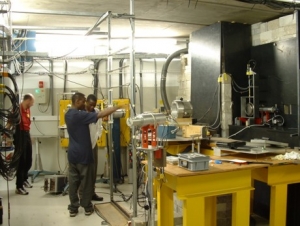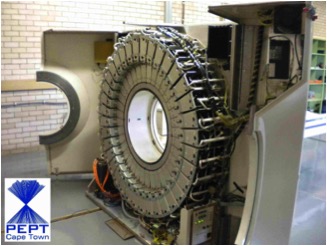Fundamental and applied nuclear physics research mainly takes place within the department and at iThemba LABS national laboratory.
The iThemba Laboratory for Accelerator-Based Sciences is a group of multi-disciplinary research laboratories administered by the National Research Foundation, at a site located 30 km from UCT. The main facility is a 200 MeV cyclotron which supplies particle beams for basic and applied research.

Nuclear physics research interests of UCT Physics currently includes:
- Gamma ray spectroscopy with the AFRODITE array at iThemba LABS
- Reaction studies with the magnetic spectrometer at iThemba LABS
- Applications using the unique fast neutron facility at iThemba LABS
- Neutron scintillation detector design and development
- Studies of secondary radiation from proton therapy beams
The ns-pulsed neutron beam facility at iThemba LABS (shown above) is unique facility with respect to the quality, time characteristics, and energy spectra of quasi-monoenergetic neutron beams it can produce, in the range 30 MeV to 200 MeV. Plans are advanced to develop this facility to a ISO-accredited high energy neutron beam reference standard, the only facility of its type in the world.
The department also operates a D-T 14 MeV neutron generator and active laboratories focusing on uses of scintillators and fast electronics, and also has expertise in radiation transport codes, most notably GEANT4.

The department also operates a positron emission particle tracking (PEPT) laboratory (“PEPT Cape Town”) at iThemba LABS. PEPT is a technique for measuring the trajectory of a single tracer particle moving within a system of granular or liquid flow, or attached to a moving rigid body. At the basis of PEPT is the labelling of the tracer with a “PET” radionuclide which decays via the emission of a positron. If both quanta of 511 keV annihilation quanta are detected at two points in space, thereby defining their line of response (LOR), then the origin of these gamma rays must have occurred somewhere along this straight line. The position of this tracer particle can be measured within the field of view of a PET camera but detecting and triangulating many LORS recorded within a short period of time. Since many thousands of coincidence events can be detected in a PET camera and processed each second, the possibility of tracking the position of a fast moving particle may be realised. PEPT Cape Town houses the very sensitive Siemens HR++ PET scanner (shown) and an ADAC gamma camera modified for PEPT. We also have an established laboratory for PEPT tracer production and research.





